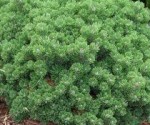 Pines in containers provide year round greenery. Some have attractive bark and cones as well as unique growth habits. Some can even be used as Christmas trees indoors for a couple of weeks, outdoors for many weeks. If you have a yen to grow a pine in a container there are a few that will do well with the proper care. Some are familiar and easy to find in nurseries, others may have to be purchased from mail order sources.
Pines in containers provide year round greenery. Some have attractive bark and cones as well as unique growth habits. Some can even be used as Christmas trees indoors for a couple of weeks, outdoors for many weeks. If you have a yen to grow a pine in a container there are a few that will do well with the proper care. Some are familiar and easy to find in nurseries, others may have to be purchased from mail order sources.
Here are five pines that can grow well in containers.
 Japanese Black Pine (Pinus thunbergiana)
Japanese Black Pine (Pinus thunbergiana)
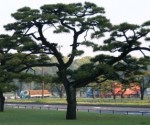 Japanese black pine is valued as an ornamental for its beautiful shape. Plants are often multi-stemmed with contorted branches that are held horizontally. The needles are concentrated near the tips of the branchlets and are twisted, stiff and dark green providing an attractive backdrop for the candles. Tolerant of salt spray and air pollution.
Japanese black pine is valued as an ornamental for its beautiful shape. Plants are often multi-stemmed with contorted branches that are held horizontally. The needles are concentrated near the tips of the branchlets and are twisted, stiff and dark green providing an attractive backdrop for the candles. Tolerant of salt spray and air pollution.
-
Needle Color: Dark green
Texture: Medium
Form: Irregular, wind-swept look; pyramidal when young, spreading with age
Hardiness: Zones 5-8
Outstanding Selections:
-
‘Oculus-draconis’ (needles with yellow crossbands)
‘Kotobuki’ (small size, short needles)
 Tanyosho Pine (Pinus densiflora ‘Umbraculifere’)
Tanyosho Pine (Pinus densiflora ‘Umbraculifere’)
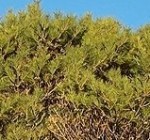 Also called Japanese umbrella pine this handsome tree is usually multi-stemmed with spreading branches The bright green needles are twisted and born in bunches on the top of stems. Unlike Japanese black pine it is not tolerant of salt spray.
Also called Japanese umbrella pine this handsome tree is usually multi-stemmed with spreading branches The bright green needles are twisted and born in bunches on the top of stems. Unlike Japanese black pine it is not tolerant of salt spray.
-
Needle Color: Bright green
Texture: Medium
Form: Vase to umbrella-shape with flat top
Hardiness: Zones 3-7
 Scotch Pine (Pinus sylvestris)
Scotch Pine (Pinus sylvestris)
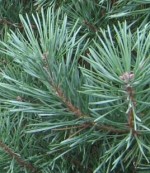 The Scotch pines are perhaps best known for their use as a cut Christmas tree but they do well in containers too. Their conical shape, horizontal branching and red-orange bark that is revealed as the outer park peels make them especially attractive.
The Scotch pines are perhaps best known for their use as a cut Christmas tree but they do well in containers too. Their conical shape, horizontal branching and red-orange bark that is revealed as the outer park peels make them especially attractive.
-
Needle Color: Blue-green
Texture: Medium
Form: Conical becoming flat topped with age
Hardiness: Zones 2 to 8a
Outstanding Selections:
-
‘Aurea’ (light green needles)
‘Spaan’s Fastigiate’ (columnar)
‘Hillside Creeper’ (lowgrowing)
 Brisltecone Pine (Pinus aristata)
Brisltecone Pine (Pinus aristata)
 Noted for its longevity in the wild, this pine grows very slowly. The needles are borne in bunches of five on the last 12 inches of the branches giving it the look of a bottle brush. It is native to high elevations in the mountains of western United States and is best suited to cold areas.
Noted for its longevity in the wild, this pine grows very slowly. The needles are borne in bunches of five on the last 12 inches of the branches giving it the look of a bottle brush. It is native to high elevations in the mountains of western United States and is best suited to cold areas.
-
Needle Color: Bluish-green
Texture: Medium
Form: Shrubby, dwarf, irregular growth pattern
Hardiness: Zones 4-7
Outstanding Selection: ‘Sherwood Compact’
 Mugo Pine (Pinus mugo)
Mugo Pine (Pinus mugo)
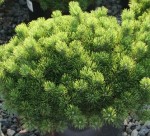 One of the few pines that will tolerate some shade, mugo pine is a dwarf tree that grows slowly. The needles stay on the tree for four years making the tree especially dense.
One of the few pines that will tolerate some shade, mugo pine is a dwarf tree that grows slowly. The needles stay on the tree for four years making the tree especially dense.
-
Needle Color: Bright green
Texture: Medium
Form: Dense shrub or multi-stemmed tree
Hardiness: Zones 3-7
Outstanding Selections:
-
var. mugo (forms dense mound)
var. ‘Amber Gold (compact with orange-yellow needs in cold weather)
var. pumilo (wide growing ground cover type)
‘Slowmound” (slow growing mound form)
‘Mops’ slow growing globe-shaped form)
 Pines grown in a container need an ordinary soil mix but need excellent drainage and frequent watering. They will need a couple of applications of fertilizer every year and will need to be repotted every few years. All but mugo pine need full sun. With proper care pines in containers can last up to ten years. The hardiness zones given for each plant above have been established for plants growing in the ground and should be adjusted for local conditions. In general, add two climate zones to the lower figure to establish the coldest temperature of a container grown plant. This means that the hardiness zone of mugo pine in ground is 3 but in a container is more like 5. Plants grown in cold areas will probably need to be protected from extreme temperatures.
Pines grown in a container need an ordinary soil mix but need excellent drainage and frequent watering. They will need a couple of applications of fertilizer every year and will need to be repotted every few years. All but mugo pine need full sun. With proper care pines in containers can last up to ten years. The hardiness zones given for each plant above have been established for plants growing in the ground and should be adjusted for local conditions. In general, add two climate zones to the lower figure to establish the coldest temperature of a container grown plant. This means that the hardiness zone of mugo pine in ground is 3 but in a container is more like 5. Plants grown in cold areas will probably need to be protected from extreme temperatures.